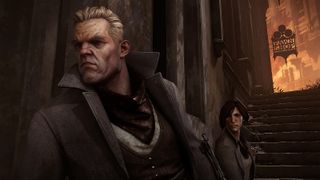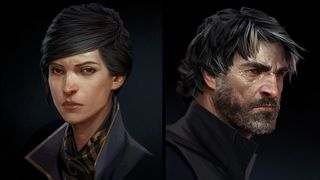Dishonored 2: a deeper, stranger stealth sim
A first look at the sequel Dishonored deserves.

Like clockwork
The mission I saw took place in the Dust District, a poor area of Karnaca in the shadow of a mountain cleft called the wind corridor. Massive overhead pipes funnel waste from silver mines out over the city, but excessive industry has buried this particular district in thick silt. Wind will be a factor all over Karnaca—you'll find turbines powering alarms and defenses just as often as whale oil canisters—but it's key to this particular mission.
Every so often, a horn heralds a dust storm that blows through the district, obscuring sight and sound for a few key moments. The first time this happens, Bakaba takes advantage by moving Emily up to a rooftop where she's able to discretely murder a number of distracted guards before disabling an elevated wind turbine.
The objective, in this case, is information. Two characters can tell you what you need to know—an Overseer and a gang leader—and they're at war with one another, with a neutral zone between them. As in the first game, it's up to you to decide how you want to unpick this situation. As Emily, Bakaba infiltrates the Overseers' headquarters, isolates his target, and rips him asunder using Shadow Walk. He then takes the corpse to the gang leader, who provides the needed information in return. The opposite approach also works, as does a head-on-assault: I saw Corvo lead a violent charge through a bloodfly-infested building, using an offensively-enhanced Blink to gain an edge in combat.
The best missions in the first game, like Lady Boyle's Party, had unique features that didn't occur anywhere else. Arkane plan to extend this principle across every mission in Dishonored 2. The Dust District's warring factions and periodic storms are one example. The transforming interior of the Clockwork Mansion is another: this was suggested in the E3 trailer, but is an actual level in the game. It's a technological labyrinth where rooms reconfigure themselves with the pull of a lever, and it's even possible to crawl up into the mechanism of the house to reach your target through the walls.

Controlling chaos
Dishonored's chaos system altered the world based on the player's approach. The more people you killed, the darker and more rat-infested Dunwall became. Plot points were made darker and more violent as a reflection of 'your' Corvo. This drew some criticism, as it seemed to punish players for using many of the game's most entertaining powers and gadgets. There are few non-lethal applications for a man-eating rat swarm, after all, or for a spring trap packed with razor blades.
It may be surprising, therefore, to learn that the chaos system is back—and that its reach has been extended. Different levels of chaos will affect the events of the game and the attitude expressed by Corvo and Emily. Arkane's approach to fixing the problem with chaos hasn't been to alter the system itself. Instead, they're offering a better balance of lethal and non-lethal ways to play.
Those branching skill trees will include more non-lethal applications for the powers both Corvo and Emily have. Both characters also have access to a suite of new non-lethal combat moves and gadgets, including flashbang crossbow bolts, the ability to grab and choke out enemies in combat, and a variant on the previously-lethal drop-assassination that gives your target a thump on the head rather than a sword in the neck.
The biggest gaming news, reviews and hardware deals
Keep up to date with the most important stories and the best deals, as picked by the PC Gamer team.
Arkane's approach to fixing the chaos system: offering a better balance of lethal and non-lethal ways to play.
If you played a lot of the first game, this expansion to your toolset is just as important as Emily's otherworldly new powers. 'Non-lethal' no longer means 'perfectly stealthy': if you get spotted, you can parry your opponent's incoming blade, translate that into a grab, choke them unconscious, and hide their sleeping body somewhere. If they didn't sound an alarm and nobody saw, you got away with it. Contrast with the first game, where getting seen forced you to either run (and deal with an alert state) or kill them (and give up on your dream of being Batman.)
"Some people were wondering if chaos was making the game too difficult," Bakaba says. "It's not making the game more difficult, it's making an experience where you deal with the consequences."
There are smart changes being made to the simulation elsewhere, too. Guards now have a limited ability to climb in order to chase you, and Karnaca's flat rooftops mean there's more danger higher up than there was before. "We don't want to break that feeling of 'get up to be safer,'" Bakaba says, "but we also heard the feedback that some people want to play a Dishonored game where that's not as safe."
Your ability to tweak the experience has also been expanded with custom difficulty modifiers. Bakaba wouldn't go into detail about all of these, but they include a variety of changes to the AI. You can extend their vision cone to give them more vertical awareness, for example, or change it so that leaning out of cover at the wrong time instantly reveals you (you were completely invisible while leaning in the first game, whereas your window of safety is more limited in the second.)

Edge of the empire
Karnaca has a long legacy of colonisation, and this is reflected in its architecture, its culture, and the people who walk its streets. "Karnaka is in the south of our Empire and it's influenced heavily by southern Europe," Smith says. "Bits of Greece, bits of Spain, bits of Italy."
Dishonored 2 shares its predecessor's art style, but benefits from a new generation of technology—including a new engine, Void, based on id Tech 5. Void allows for better lighting and post-processing in pursuit of a familiar look and feel: angular, haunted faces, teetering brickwork shot through with retro-futuristic industrial technology. The goal of Arkane's art team is still to create a game you could mistake for a painting—new tech just lets them make a game that looks like a better painting.
"There's no major change in the sensibility of these two games," says Sebastién Mitton, art director. "Dishonored 2, I wanted it to be, visually, a journey to a new city. We kept some pillars—oppression, disease, magic, decay."
Karnaca isn't Dunwall, however—rainslick terraces have been swapped for sunbaked Mediterranean colonnades, flooding for the thick jungle that encroaches on the city from three sides. There's a sense of heat, more life in the streets, and corruption takes a different form. Bloodflies make hives in abandoned buildings, planting their spawn in corpses (including the ones you create). Karnaca is evocative, new and familiar all at once—definitely a city in the same world as Dunwall, but its own place nonetheless.
The process by which Mitton and his team create these places is one of the most fascinating things about the game's development. "It's an organic process," Mitton says. "we propose stuff, we mock up super quickly, we give moods through illustration or photo reference, we discuss with [design]." Collaboration with the level designers begins early, but historical and architectural concerns are important too—and they feed back into the game itself. In creating the Dust District, for example, Arkane considered how wind would shape a city. "Suddenly the district has that diamond shape, the windbreakers," Mitton points out. "Some people will notice, some will not, but it's there and it's powerful, gorgeous. You can create circulation behind a windbreaker, you can have hidden windows that open, and that's really cool for everyone: for me, for the team, for the level designers too."

Diversity, community
An underappreciated success of the first Dishonored is the community it fostered. There is, I think, a correlation between artistic credibility, diversity, player agency, and fandom. Dishonored reached more people than another immersive sim might because it looked unlike any other game of its type. It had an artistic and literary sensibility that placed it off to the side of traditional videogame subject matter. It had characters with character and a world with soul. It became a meeting point for all sorts of different creative people: skilled players making video montages, cosplayers, fan artists, and so on.
This success is something that Arkane want to build on for Dishonored 2, and showcasing a diverse range of voices is a major part of this. "For whatever reason, we have a wider range of demographics who like our game than is traditionally true and I love that," Smith says. "I love writers like Ta-Nehisi Coates who talk about how important it is to have a representational avatar for a comic or game or a film that looks like you, that reminds you that you could be that guy. Whether it's a man, a woman, their ethnic background—not just a grizzled white dude whose wife's been murdered and he's gotta go out one more time."
"That's an easy trap to fall into," Smith continues. "We found so far that the more we include other types of people in the world, the more it resonates with a wider range of people and it doesn't hurt the core audience at all. It doesn't hurt the core fantasy at all."
Diversifying Dishonored started in the first game's DLC. "We always wanted to have female gang members," Smith says. "We had these colourful UK-type gang members in the first game, the Hatters and Slackjaw's group. We always wanted Victorian-style tough women in striped pants with bowler hats, with rings on their hands kicking ass in an alley. So for the DLC we added some gangs like that—the Dead Eels were led by Lizzy Stride. We double down on that for Dishonored 2—we have a female protagonist as well as a male protagonist, we have female gang members, we have female officers in the city watch, the Grand Serkonan Guard. We have female villains and assassination targets."

Long shadows
Based on what I saw at Arkane, I’m excited for Dishonored 2, and not just as a fan of the first. There was a time when it was rare for a game like this to get a sequel, let alone one that has been given the time, freedom and resources it needs to succeed. If you ever thought ‘they don’t make them like they used to’ during the triple-A funk of the mid-noughties, then Dishonored was a reassuring return to form. Dishonored getting a proper sequel takes that further. It suggests that you can stop thinking about how they used to make them, and start getting excited about how they make them now.
Joining in 2011, Chris made his start with PC Gamer turning beautiful trees into magazines, first as a writer and later as deputy editor. Once PCG's reluctant MMO champion , his discovery of Dota 2 in 2012 led him to much darker, stranger places. In 2015, Chris became the editor of PC Gamer Pro, overseeing our online coverage of competitive gaming and esports. He left in 2017, and can be now found making games and recording the Crate & Crowbar podcast.
Most Popular




